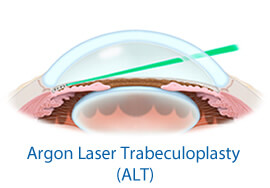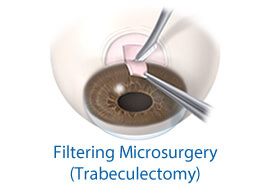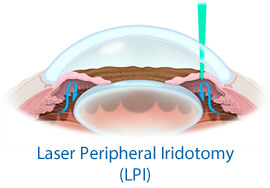Trabeculectomy
Glaucoma Surgery
Glaucoma is an eye disease in which pressure inside the eye (intraocular pressure) rises dangerously high, damaging the optic nerve and causing vision loss. In a healthy eye, fluid is produced in the ciliary body, enters the eye, and then drains through tiny passages called the trabecular meshwork. In people with glaucoma, these passages become blocked and intraocular pressure rises.



Some cases of glaucoma can be treated with medications. For others, laser or traditional surgery is required to lower eye pressure. Common surgeries include:
Argon Laser Trabeculoplasty (ALT)
For patients with primary open angle glaucoma (POAG). The trabecular passages are opened to increase fluid drainage. ALT is effective in about 75% of patients.
Filtering Microsurgery (Trabeculectomy)
For patients who have not been helped with laser surgery or medications. A new drainage passage is created by cutting a small hole in the sclera (the white part of the eye) and creating a collection pouch between the sclera and conjunctiva (the outer covering of the eye).
Laser Peripheral Iridotomy (LPI)
For patients with narrow-angle glaucoma. A small hole is made in the iris to increase the angle between the iris and cornea and encourage fluid drainage.
Nd: YAG Laser Cyclophotocoagulation (YAG CP)
For patients with severe glaucoma damage who have not been helped with other surgeries. The ciliary body that produces intraocular fluid is destroyed.
Selective Laser Trabeculoplasty (SLT)
For patients with primary open angle glaucoma (POAG). SLT utilizes an Nd:YAG laser that is very precise in its management of the trabecular meshwork. The trabeculocytes are responsible for draining ocular fluid into Schlemm’s canal in order to regulate the IOP. The exact mechanism through which the Nd:YAG laser affects the trabecular meshwork is not understood, but it has been found to be quite effective in stabilizing IOP nonetheless. SLT may be repeated.
Tube Shunt Surgery
May be recommended for patients with neovascular glaucoma, failed trabeculectomy, or susceptibility to developing scar tissue. A thin, flexible tube (a shunt) with a silicone pouch is inserted in the eye to facilitate drainage.

